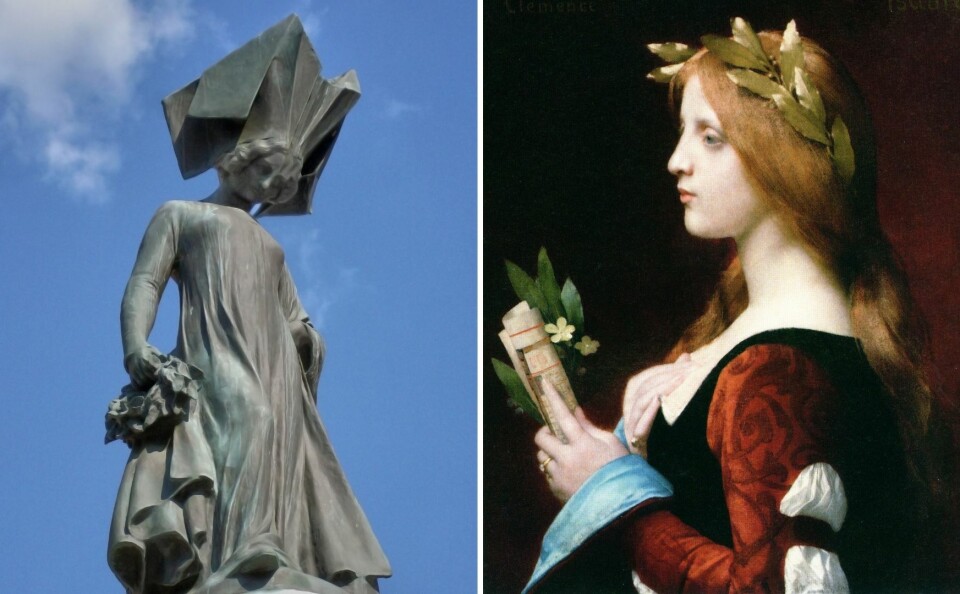-
Duck Cold! Four French phrases to use when it is freezing outside
We remind you of French expressions to use to describe the drop in temperature
-
When and why do we say le moral dans les chaussettes?
We explore this useful expression that describes low spirits
-
The origins and meaning of tirer les marrons du feu
As Christmas approaches, we look at a phrase to describe someone who takes advantage of a situation
Toulouse’s medieval myth, poet and muse, Clémence Isaure
We explore the fantastical story of the Floral Games and its legendary benefactor

Clémence Isaure is the legendary figurehead of Toulouse’s Floral Games, an annual poetry competition that has taken place nearly every year since 1324.
In her southern hometown city of Toulouse, she is as famous as Joan of Arc.
Her name graces road signs and schools all over the southwest, while her face is immortalised in paintings and sculptures.
She has been celebrated and admired over the centuries as a poet, a patron, a judge, a virgin goddess, a romantic heroine, and a muse.
She continues to be the poster girl for Europe’s oldest literary academy, the Academy of the Floral Games.
Yet there is not a shred of evidence that this woman ever existed.
Read more: Are the English really guilty of Joan of Arc’s death?
So who was Clémence Isaure and how did she gain her mythical status?
The story starts in Toulouse in 1323, when seven troubadours (chivalric poet performers) came together to celebrate poetry written in the local language of Occitan, the langue d’oc.
They launched a competition, calling for poets to submit an example of their work, the best of which would win a prize.
The following year, on the Feast of the Violet, 3rd May 1324, Arnaud Vidal won the top prize of a golden violet flower at the town’s first Floral Games.
The precious gilded flower prizes, and the slap-up feast that took place afterwards, were funded by the town councillors.
When the original seven troubadours died, they were replaced by other Toulouse nobles, who stopped awarding glittering prizes and met only to celebrate the Feast of the Violet.
The company seems to have disbanded altogether in 1484.
Read more: Gardening in France: The history of Toulouse’s Parma violets
Clémence re-started and funded the Floral Games
It is from this culturally gloomy atmosphere that the figure of Clémence Isaure emerged as the saviour of the Floral Games.
In 1496, records describe how a Toulouse woman called Clémence Isaure re-started the annual competition, introducing new awards and new golden flowers, which she personally designed and then distributed to the winning poets.
When she died, she is said to have bequeathed her vast fortune to the company of poets, the Consistoire du Gai Savoir, to ensure the Floral Games would continue in perpetuity.
In the sixteenth century, members of the Consistoire du Gai Savoir, curious about how their annual games and prizes were funded, asked the town councillors to show them Isaure’s testament.
In 1540 the councillors refused to show them, and then when asked again in 1544, said they had never seen it.
The testament has never been recovered, a fact that seems only to have further fuelled the making of Clémence Isaure’s myth.
Statue of dead noblewoman renamed Clémence
The first statue commemorating her personifies the murky provenance of Clémence’s existence.
Records show that in the sixteenth century, the fourteenth-century effigy of a woman from the noble Ysalguier family, whose tomb lay in a local church, was taken from its funerary location and turned into an upright statue.
The statue was re-named Clémence Isaure and placed on a pedestal in a room at the Capitole where the Consistoire du Gai Savoir held its meetings.
The up-cycled statue even had an engraved epitaph mounted on its plinth, the text almost certainly relating to another person.
In the seventeenth century, a famous local sculptor was paid to add some details to the statue – new arms, some flowers in one hand and a scroll in the other – to make her a more convincing likeness for the legendary benefactor of Toulouse’s Floral Games.
Clémence Isaure legend lives on
The myth of Clémence Isaure gained momentum, reaching its zenith in the nineteenth century, the period when the majority of the art celebrating her was produced.
Paintings and statues depict her in a variety of improbable and unrelated scenarios, including as a tragic heroine and as a Christian guardian of the arts.
In Place de la Concorde in Toulouse, she towers over the square from her plinth, her head framed by a remarkable headpiece that is more a celebration of Art Nouveau aesthetics than a nod to actual medieval fashion.
The jury is still out as to whether Clémence Isaure is fact or fiction. To the people of Toulouse, this hardly matters. Her legend lives on in art.
Related articles
Find medieval knights and monsters painted on Narbonne palace ceiling
Discover medieval underground cave churches in Nouvelle-Aquitaine
Two saints buried in one tomb still draws pilgrims to French priory
























